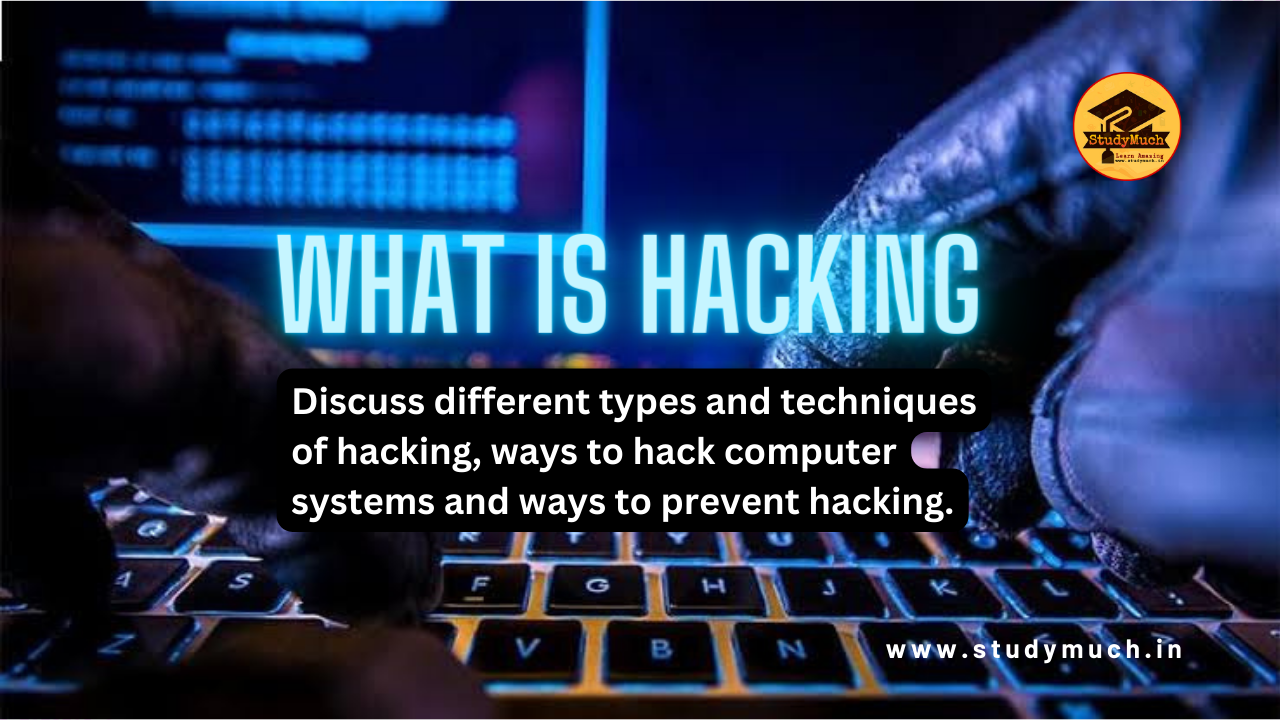What is Hacking

What is Hacking: Unveiling the World of Ethical Hacking and its Complex Techniques;
In today’s digital age, where technology plays an integral role in our lives, the term “hacking” often has a negative connotation. However, not all hacking is malicious or illegal. In fact, there is a branch of hacking known as ethical hacking, which serves an important purpose in securing systems, networks, and data. In this blog post, we will explore the concept of hacking, What is Hacking, ethical hacking, discuss different types and techniques of hacking, ways to hack computer systems and ways to prevent hacking.
What is Hacking?
Hacking is the art of manipulating computer systems, networks, or software applications to gain unauthorized access or control. It involves probing, testing, and exploiting vulnerabilities in order to bypass security measures or obtain valuable information. While hacking is often associated with illicit activities, it’s important to differentiate between ethical hacking and its malicious counterpart.

Ethical Hacking:
Ethical hacking, also known as penetration testing or white-hat hacking, is a legitimate and authorized practice that aims to identify vulnerabilities in systems and strengthen their security. Ethical hackers are skilled professionals who apply their expertise to uncover weaknesses before malicious hackers can exploit them. They work closely with organizations, governments, and individuals to enhance cybersecurity and protect sensitive information.
However, it is essential to note that ethical hacking should always be performed within legal boundaries and with proper authorization. Ethical hackers adhere to a strict code of conduct, ensuring that their activities are aimed at improving security rather than causing harm. They work in collaboration with organizations, promoting a symbiotic relationship that fosters trust and cooperation.
Types of Hacking:
Network Hacking: This type of hacking focuses on exploiting vulnerabilities within computer networks. It involves techniques such as network scanning, sniffing, and password cracking to gain unauthorized access to network resources.
Website Hacking: Website hacking targets vulnerabilities in web applications and websites. Attackers may employ techniques like SQL injection, cross-site scripting (XSS), and session hijacking to compromise a website’s security.
Social Engineering: Social engineering is a psychological approach used to manipulate individuals and exploit their trust. Hackers may employ techniques like phishing, pretexting, or baiting to trick people into revealing sensitive information or performing actions that compromise security.
Wireless Hacking: Wireless networks are susceptible to hacking due to their inherent vulnerabilities. Hackers use tools and techniques like WiFi eavesdropping, cracking encryption, or creating rogue access points to gain unauthorized access to wireless networks.
Hacking Techniques:
- Password Cracking: This technique involves deciphering passwords to gain unauthorized access. Attackers may employ methods like brute-forcing, dictionary attacks, or rainbow table attacks to crack passwords.
- Malware Attacks: Malicious software, commonly referred to as malware, is designed to compromise systems or steal data. Techniques such as phishing emails, trojans, ransomware, and keyloggers are used to distribute malware.
- Denial of Service (DoS) Attacks: DoS attacks aim to overload a system or network by flooding it with excessive traffic, rendering it inaccessible to legitimate users. This technique disrupts services and causes significant damage.
Methods of Hacking Computer Systems:
- Vulnerability Assessment: Ethical hackers conduct a comprehensive assessment of systems and networks to identify potential vulnerabilities. This involves using automated tools, analyzing system configurations, and performing security audits.
- Exploiting Vulnerabilities: Once vulnerabilities are identified, ethical hackers attempt to exploit them. This process involves using various tools, techniques, and attack vectors to gain unauthorized access or control over the targeted system.
- Reporting and Remediation: After successful exploitation, ethical hackers report their findings to the system owners. They provide detailed reports outlining the vulnerabilities discovered and suggest remediation steps to mitigate the risks.
Protect against Hacking;
To protect against hacking, individuals and organizations can also adopt security best practices. These include using strong and unique passwords, keeping software and systems up to date, implementing multi-factor authentication, regularly backing up data, and educating users about common social engineering techniques.
Protecting against hacking requires a proactive approach to cybersecurity. Here are key points to consider in order to enhance your defenses and safeguard against hacking:
- Strong and Unique Passwords: Use strong, complex passwords that include a combination of uppercase and lowercase letters, numbers, and special characters. Avoid using easily guessable information such as personal details or common phrases. Additionally, ensure that you use a unique password for each online account.
- Multi-Factor Authentication (MFA): Enable MFA whenever possible. This adds an extra layer of security by requiring additional verification, such as a code sent to your phone, in addition to your password.
- Keep Software and Systems Updated: Regularly update operating systems, software applications, and firmware to ensure you have the latest security patches. Cybercriminals often exploit known vulnerabilities, so staying up to date is crucial in mitigating risks.
- Use Reliable Security Software: Install reputable antivirus and anti-malware software on all devices. Keep the software updated to detect and remove any malicious programs that may compromise your system.
- Be Cautious with Email and Attachments: Exercise caution when opening email attachments or clicking on links, especially if they come from unknown or suspicious sources. Verify the authenticity of emails before responding or providing sensitive information.
- Educate and Train Users: Provide cybersecurity awareness training to employees and family members. Teach them about common hacking techniques, such as phishing and social engineering, and how to recognize and report suspicious activities.
- Regularly Back Up Data: Implement a robust backup strategy for all critical data. Regularly back up your files and verify that the backups are functioning correctly. This ensures that in the event of a successful attack, you can recover your data without paying ransom or suffering permanent loss.
- Secure Wi-Fi Networks: Protect your wireless networks with strong encryption (e.g., WPA2 or WPA3). Change default router passwords and use a unique, strong password for your Wi-Fi network.
- Enable Firewalls: Activate firewalls on all devices and networks. Firewalls act as a barrier between your devices and the internet, filtering out potentially malicious traffic.
- Regular Security Assessments: Conduct periodic security assessments and audits to identify vulnerabilities in your systems and networks. Engage ethical hackers or security professionals to perform penetration tests and vulnerability assessments to proactively identify weaknesses.
- Limit Access and Privileges: Implement the principle of least privilege by granting users only the access and permissions necessary for their roles. Regularly review and revoke unnecessary privileges to minimize the potential impact of a successful attack.
- Stay Informed: Keep yourself updated on the latest cybersecurity trends, threats, and best practices. Follow reputable sources for information and stay vigilant about emerging threats.
Remember, protecting against hacking is an ongoing process. By implementing these measures and staying proactive, you can significantly reduce the risk of falling victim to hacking attempts and enhance the security of your digital assets.

Conclusion:
Hacking, in its essence, is a complex and multifaceted domain. While it is often associated with negative connotations, ethical hacking serves as a crucial defence mechanism to protect systems, networks, and sensitive information from malicious hackers. Ethical hackers play a vital role in identifying vulnerabilities and strengthening cybersecurity measures.
Understanding the concept of hacking, including ethical hacking, types of hacking, and various hacking techniques, allows us to appreciate the importance of protecting our digital assets. By staying informed about potential risks and adopting robust security practices, we can safeguard our systems and data from unauthorized access. so, you have learned all about the Hacking, I hope you have understood this, but if you have any doubt you can ask in the comment section.
Learn More;
- Learn What is Hacking.
- What is Ethical Hacking.
- Create PAN Card Online Process.
- Learn Computer System Hacking.
- Learn about Computer Networking.
- Learn about the Operating System of computer.



0 Comments